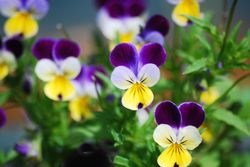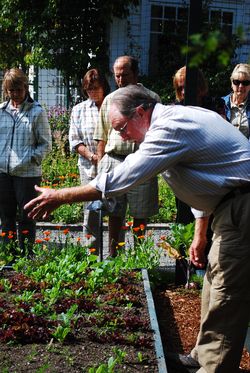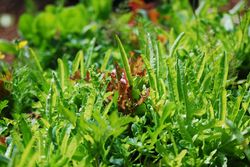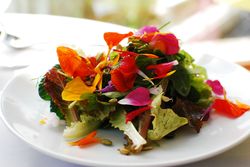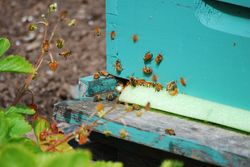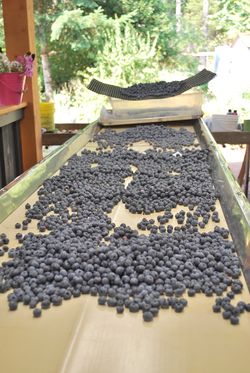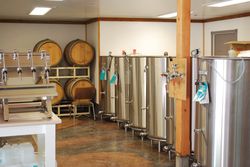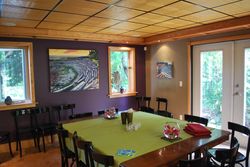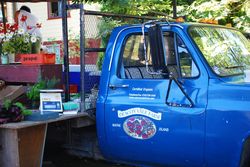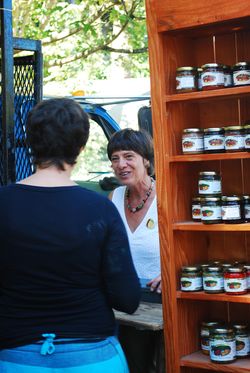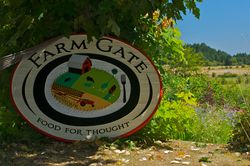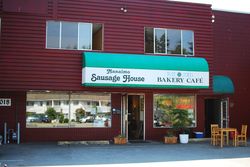 For thousands of years humans didn’t have such things as refrigerators and freezers, so they had to become pretty inventive when it came to preserving foods for pantries barren of fresh foods over the winter. Part of that invention included smoking and curing meats from their farm animals, and while we can freeze meat for later use quite easily, smoking and curing is something we still do because we love the flavour. At least many of us do, including of course, me!
For thousands of years humans didn’t have such things as refrigerators and freezers, so they had to become pretty inventive when it came to preserving foods for pantries barren of fresh foods over the winter. Part of that invention included smoking and curing meats from their farm animals, and while we can freeze meat for later use quite easily, smoking and curing is something we still do because we love the flavour. At least many of us do, including of course, me!
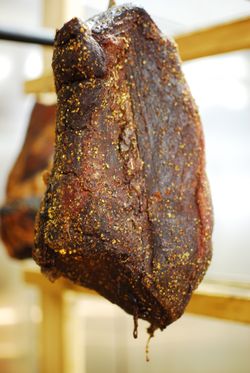 I have always loved cured and smoked meats, hams, sausages, salamis, bacon, any part of an animal that has been salted or brined and cured and possibly smoked. When I spent a year studying food culture in Italy, salumi, or cured meats, was a required course of study and any field trip we went on to any European country usually involved a visit to some artisan who specialized in cured meat.
I have always loved cured and smoked meats, hams, sausages, salamis, bacon, any part of an animal that has been salted or brined and cured and possibly smoked. When I spent a year studying food culture in Italy, salumi, or cured meats, was a required course of study and any field trip we went on to any European country usually involved a visit to some artisan who specialized in cured meat.
We don’t have as much of a long-standing tradition here in Canada. Well, it is out there, but definitely not as pronounced here on the west coast as it is in provinces where there are stronger pockets of European immigrants…so in Quebec and Ontario and some of the Eastern European pockets across the Prairies there is still some authentic local production, but we seem to rely on a lot of imported product on Vancouver Island, whether it’s imported from overseas or from the rest of Canada. So imagine my delight when I first tasted the products of the Nanaimo Sausage House at a local food festival there. I had to go directly to the source and caught up with Catherine Clarke, one of the current owners of the Sausage House.
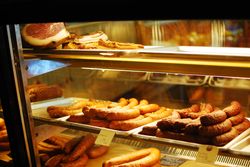 They specialize in a lot of Eastern European style products that are usually smoked, so a little bit different from the Italian and Spanish products I’m used to, which are primarily cured, with no smoking once they’ve been cured. They also make fresh sausages (about 30 different kinds) perfect for your barbecue. As Catherine took me through their showcase I couldn't help but start slathering at all the aromatic and yummy-looking sausages, ranging from Hungarian to Polish kielbasa types, to hams and bacons, all made from hormone-free pork raised in the Fraser Valley. No fillers, preservatives or binders are used. They also make some products using Vancouver Island bison!
They specialize in a lot of Eastern European style products that are usually smoked, so a little bit different from the Italian and Spanish products I’m used to, which are primarily cured, with no smoking once they’ve been cured. They also make fresh sausages (about 30 different kinds) perfect for your barbecue. As Catherine took me through their showcase I couldn't help but start slathering at all the aromatic and yummy-looking sausages, ranging from Hungarian to Polish kielbasa types, to hams and bacons, all made from hormone-free pork raised in the Fraser Valley. No fillers, preservatives or binders are used. They also make some products using Vancouver Island bison!
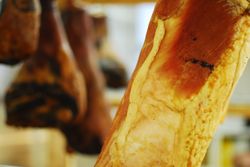 If you think Catherine Clarke doesn’t sound like a very European name, her business partner, Pawel Biegun, has the European pedigree and they were looking for opportunities. He had known the couple who started the Sausage House since he arrived from Poland 20 years ago, so they bought into a company that already had been operating for 20 years and have now run it successfully for 10 more years. The couple passed on all of their recipes and methodology, which has remained unchanged, although Catherine and Pawel have put into place some processes that have made the operation a little more efficient.
If you think Catherine Clarke doesn’t sound like a very European name, her business partner, Pawel Biegun, has the European pedigree and they were looking for opportunities. He had known the couple who started the Sausage House since he arrived from Poland 20 years ago, so they bought into a company that already had been operating for 20 years and have now run it successfully for 10 more years. The couple passed on all of their recipes and methodology, which has remained unchanged, although Catherine and Pawel have put into place some processes that have made the operation a little more efficient.
 Here are some of their grilling sausages I tried, their North African made with sun-dried tomato, cilantro and pine nuts, as well as their turkey sausage made with sun-dried red peppers. The dense meaty flavour is complemented by a very moist texture…I think I need to try some of the other 28 varieties!
Here are some of their grilling sausages I tried, their North African made with sun-dried tomato, cilantro and pine nuts, as well as their turkey sausage made with sun-dried red peppers. The dense meaty flavour is complemented by a very moist texture…I think I need to try some of the other 28 varieties!
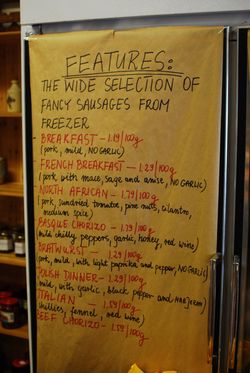 I always worry about businesses like this surviving in the future, because it not really a turn-key operation, someone really needs to learn the craft like Catherine and Pawel have, and we live in a world where we often forget what a hand-crafted product is supposed to taste like. But Catherine is optimistic our attitudes are changing, more people are appreciating good quality in artisanal products, and that will keep them going.
I always worry about businesses like this surviving in the future, because it not really a turn-key operation, someone really needs to learn the craft like Catherine and Pawel have, and we live in a world where we often forget what a hand-crafted product is supposed to taste like. But Catherine is optimistic our attitudes are changing, more people are appreciating good quality in artisanal products, and that will keep them going.
Nanaimo Sausage House does not do mail order, but if you don't live in Nanaimo maybe someone who is passing through can take along a cooler and pick up some of the frozen product. The smoked hams and sausages keep quite well for weeks in your fridge.
If you are in Nanaimo, the Sausage House is at 3018 Ross Road, behind the Country Club Mall. Call them at 250-751-0555.
And just a heads-up if you are looking to purchase some sausages for the long weekend, they get VERY busy before long weekends!
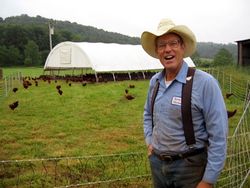 I've been wanting to meet Joel Salatin for quite some time now, ever since I read about him in The Omnivore's Dilemma and watched him in the Food, Inc. documentary.
I've been wanting to meet Joel Salatin for quite some time now, ever since I read about him in The Omnivore's Dilemma and watched him in the Food, Inc. documentary.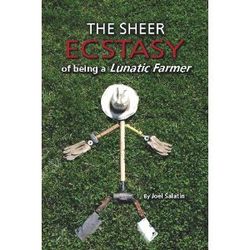 If you live in Vancouver, your chance to meet Joel Salatin happens Monday night, September 27th at UBC. Proceeds from ticket sales at this event organized by Barbara-jo's Books to Cooks benefit UBC Farm and your ticket price includes a copy of Joel's book, The Sheer Ecstasy of being a Lunatic Farmer. I'll be at the UBC event, I hope to see you there. In November, I'll be doing a talk of my own in Courtenay organized by Brambles, more details about that soon.
If you live in Vancouver, your chance to meet Joel Salatin happens Monday night, September 27th at UBC. Proceeds from ticket sales at this event organized by Barbara-jo's Books to Cooks benefit UBC Farm and your ticket price includes a copy of Joel's book, The Sheer Ecstasy of being a Lunatic Farmer. I'll be at the UBC event, I hope to see you there. In November, I'll be doing a talk of my own in Courtenay organized by Brambles, more details about that soon. 
